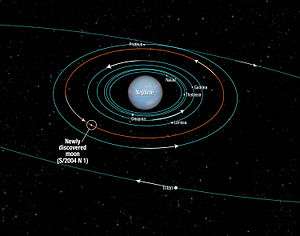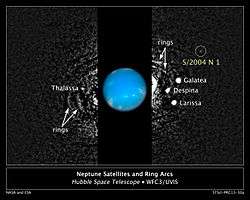S/2004 N 1
|
Composite of Hubble images from 2009 showing Neptune, its rings, S/2004 N 1, and other inner moons. The relative brightness of the moons is exaggerated. | |
| Discovery | |
|---|---|
| Discovered by | M. R. Showalter, I. de Pater, J. J. Lissauer, R. S. French[1] |
| Discovery date | July 1, 2013 |
| Orbital characteristics[2] | |
| ~ 105,283 km | |
| Eccentricity | ~ 0.000[3] |
| 0.9362 d[2] | |
| Inclination |
|
| Satellite of | Neptune |
| Physical characteristics | |
Mean radius | 8–10 km[2] |
| Albedo | assumed low |
| 26.5[2] | |
S/2004 N 1 is a small moon of Neptune, about 18 km (11 mi) in diameter, which orbits the planet in just under one Earth day. Its discovery on 1 July 2013 increased Neptune's retinue of known satellites to fourteen.[4] The moon is so dim that it was not observed when Voyager 2 flew by in 1989. Mark Showalter of the SETI Institute found it by analyzing archived Neptune photographs the Hubble Space Telescope captured between 2004 and 2009.[5]
The designation "S/2004 N 1" is provisional; "2004" refers to the year the data was first acquired, not the year of discovery.
Discovery
Mark Showalter discovered S/2004 N 1 on 1 July 2013 while examining Hubble Space Telescope (HST) images of Neptune's ring arcs from 2009. He used a technique similar to panning to compensate for orbital motion and allow stacking of multiple images to bring out faint details.[4][6][7] After deciding "on a whim" to expand the search area to radii well beyond the rings,[8] he found the "fairly obvious dot" that represented the new moon.[2] He then found it repeatedly in other archival HST images going back to 2004. Voyager 2, which had observed all of Neptune's other inner satellites, did not detect it during its 1989 flyby, due to its dimness.[4] Given that the relevant images have long been available to the public, the discovery could have been made by anyone.[2]
S/2004 N 1 is the fourteenth known moon of Neptune, and the first to be discovered since September 2003,[7][9] when Psamathe was discovered.
Origin
Neptune's largest moon, Triton, has a retrograde and inclined orbit. It is hypothesized that Neptune captured it from the Kuiper belt well after Neptune's original satellite system formed. The pre-existing moons' orbits would have been shifted by this event, leading to the ejection of some moons and the collisional destruction of others.[10][11] Neptune's present inner satellites are thought to have then accreted from the resulting rubble after Triton's orbit was circularized by tidal deceleration.[12]
Physical properties
S/2004 N 1 is assumed to resemble Neptune's other inner satellites in having a surface as dark as "dirty asphalt".[6] Their geometrical albedos range from 0.07 to 0.10.[13] S/2004 N 1's apparent magnitude of 26.5 would then give it a diameter of 16 to 20 kilometres, making it the smallest of Neptune's known moons.
The near-infrared spectra of Neptune's rings and inner moons have been examined with the HST NICMOS instrument.[14][15] Similar dark, reddish material, characteristic of small outer Solar System bodies, appears to be present on all their surfaces. The data is consistent with organic compounds containing C−H and/or C≡N bonds,[15] but spectral resolution was inadequate to identify the molecules. Water ice, abundant in the outer Solar System, is believed to be present, but its spectral signature could not be observed (unlike the case of small Uranian moons).[15]
Orbital properties

S/2004 N 1 completes one revolution around Neptune every 22 hours and 28.1 minutes (0.9362 days),[2] implying a semi-major axis of 105,283 kilometres (65,420 mi), just over a quarter that of Earth's moon, and roughly twice the average radius of Neptune's rings. Both its inclination and eccentricity are close to zero.[2] It orbits between Larissa and Proteus, making it the second outermost of Neptune's regular satellites. Its small size at this location runs counter to a trend among the other regular Neptunian satellites of increasing diameter with increasing distance from the primary.[3]
The periods of Larissa and S/2004 N 1 are within about one percent of a 3:5 orbital resonance, while S/2004 N 1 and Proteus are within 0.1% of a 5:6 resonance.[Note 1] Larissa and Proteus are thought to have passed through a 1:2 mean-motion resonance a few hundred million years ago.[16][17] Proteus[16] and S/2004 N 1 have drifted away from Larissa since then because the former two are outside Neptune-synchronous orbit (Neptune's rotational period is 0.6713 day[18]) and are thus being tidally accelerated, while Larissa is within and is being tidally decelerated.[16]
Naming
The discovery team plans to submit a name proposal to the International Astronomical Union based on a figure from Greco-Roman mythology with a relationship to Poseidon or Neptune, the god of the sea,[8] consistent with the naming of other moons of Neptune.[19] Among the names under consideration is Polyphemus, the gigantic one-eyed son of Poseidon and Thoosa.[20]
Notes
- ↑ Given the moons' respective periods of 0.55465, 0.93618 and 1.12231 days, the actual ratios are 2.962:5.000:5.994.
References
- ↑ Yeomans, D. K.; Chamberlin, A. B. (2013-07-15). "Planetary Satellite Discovery Circumstances". JPL Solar System Dynamics web site. Jet Propulsion Lab. Retrieved 2013-07-17. External link in
|work=(help) - 1 2 3 4 5 6 7 8 Kelly Beatty (15 July 2013). "Neptune's Newest Moon". Sky & Telescope. Retrieved 15 July 2013.
- 1 2 3 Editors of Sky & Telescope. "A Guide to Planetary Satellites". Sky & Telescope web site. Sky & Telescope. Retrieved 2013-07-17.
- 1 2 3 "Hubble Finds New Neptune Moon". Space Telescope Science Institute. 2013-07-15. Retrieved 2013-07-15.
- ↑ "Nasa's Hubble telescope discovers new Neptune moon". BBC News. 2013-07-15. Retrieved 2013-07-16.
- 1 2 Showalter, M. R. (2013-07-15). "How to Photograph a Racehorse ...and how this relates to a tiny moon of Neptune". Mark Showalter's blog. Retrieved 2013-07-16. External link in
|work=(help) - 1 2 Grossman, L. (2013-07-15). "Neptune's strange new moon is first found in a decade". New Scientist space web site. New Scientist. Retrieved 2013-07-18. External link in
|work=(help) - 1 2 Klotz, I. (2013-07-15). "Astronomer finds new moon orbiting Neptune". Reuters. Retrieved 2013-07-16.
- ↑ Marsden, Brian G.; S/2002 N 4, MPEC 2003-S107 (30 September 2003)
- ↑ Goldreich, P.; Murray, N.; Longaretti, P. Y.; Banfield, D. (1989). "Neptune's story". Science. 245 (4917): 500–504. Bibcode:1989Sci...245..500G. doi:10.1126/science.245.4917.500. PMID 17750259.
- ↑ Agnor, C. B.; Hamilton, D. P. (2006-05-11). "Neptune's capture of its moon Triton in a binary–planet gravitational encounter". Nature. 441 (7090): 192–194. Bibcode:2006Natur.441..192A. doi:10.1038/nature04792. PMID 16688170.
- ↑ Banfield, Don; Murray, Norm (October 1992). "A dynamical history of the inner Neptunian satellites". Icarus. 99 (2): 390–401. Bibcode:1992Icar...99..390B. doi:10.1016/0019-1035(92)90155-Z.
- ↑ Karkoschka, Erich (2003). "Sizes, shapes, and albedos of the inner satellites of Neptune". Icarus. 162 (2): 400–407. Bibcode:2003Icar..162..400K. doi:10.1016/S0019-1035(03)00002-2.
- ↑ Dumas, C.; Terrile, R. J.; Smith, B. A.; Schneider, G. (March 2002). "Astrometry and Near-Infrared Photometry of Neptune's Inner Satellites and Ring Arcs". The Astronomical Journal. 123 (3): 1776–1783. Bibcode:2002AJ....123.1776D. doi:10.1086/339022. ISSN 0004-6256.
- 1 2 3 Dumas, C.; Smith, B. A.; Terrile, R. J. (August 2003). "Hubble Space Telescope NICMOS Multiband Photometry of Proteus and Puck". The Astronomical Journal. 126 (2): 1080–1085. Bibcode:2003AJ....126.1080D. doi:10.1086/375909. ISSN 0004-6256.
- 1 2 3 Zhang, K.; Hamilton, D. P. (June 2007). "Orbital resonances in the inner neptunian system: I. The 2:1 Proteus–Larissa mean-motion resonance". Icarus. 188 (2): 386–399. Bibcode:2007Icar..188..386Z. doi:10.1016/j.icarus.2006.12.002. ISSN 0019-1035.
- ↑ Zhang, K.; Hamilton, D. P. (January 2008). "Orbital resonances in the inner neptunian system: II. Resonant history of Proteus, Larissa, Galatea, and Despina". Icarus. 193 (1): 267–282. Bibcode:2008Icar..193..267Z. doi:10.1016/j.icarus.2007.08.024. ISSN 0019-1035.
- ↑ Williams, David R. (1 September 2004). "Neptune Fact Sheet". NASA. Retrieved 18 July 2013.
- ↑ "Planet and Satellite Names and Discoverers". Gazetteer of Planetary Nomenclature. USGS Astrogeology. Retrieved 2013-07-18.
- ↑ Vincent, James (16 August 2013). "Astronomers throw open the doors to the public-naming of planets". The Independent. Retrieved 16 August 2013.
External links
![]() Media related to S/2004 N 1 at Wikimedia Commons
Media related to S/2004 N 1 at Wikimedia Commons


